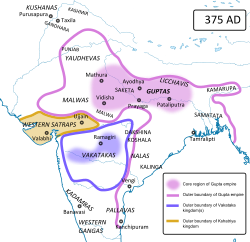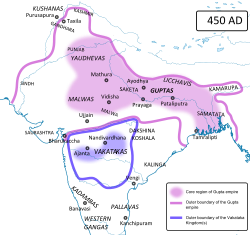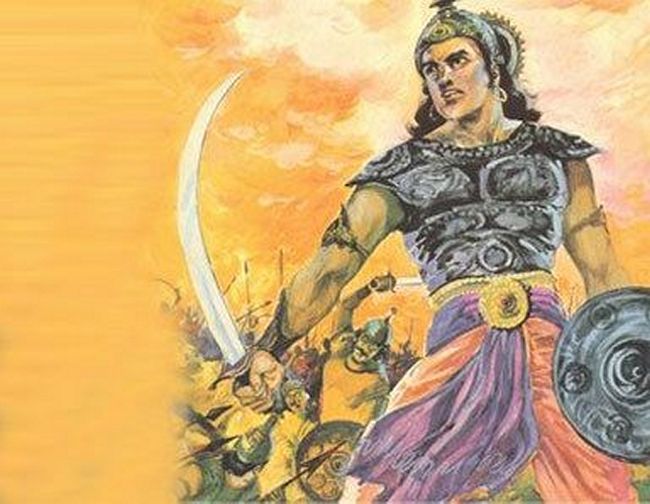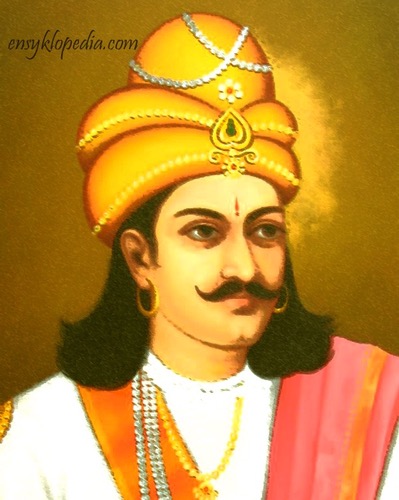Chandragupta was a son of the Gupta king
Ghatotkacha, and a grandson of the dynasty's founder
Gupta, both of whom are called
Maharaja ("great king") in the
Allahabad Pillar inscription. Chandragupta assumed the title
Maharajadhiraja and issued gold coins, which suggests that he was the first imperial ruler of the dynasty.
Chandragupta certainly reigned in the first quarter of the 4th century CE, but the exact period of his reign is uncertain. His assumption of the title
Maharajadhiraja has led to suggestions that he founded the
Gupta calendar era, and that the epoch of this era marks his coronation. Based on this argument, several historians, including
V. A. Smith and P. L. Gupta, date Chandragupta's ascension to 319-320 CE, which they believe to be the beginning of the Gupta era. However, this is merely an assumption, and the identity of the founder of the Gupta era is not certain. Some historians, such as
D. C. Sircar and
R. C. Majumdar, theorize that the Gupta era marks the coronation of his son Samudragupta. S. R. Goyal theorizes that the era was started by the later king
Chandragupta II, but its beginning was dated to Samudragupta's ascension.
Chandragupta I probably had a long reign, as the Allahabad Pillar inscription suggests that he appointed his son as his successor, presumably after reaching an old age. However, the exact period of his reign is debated.
Various estimates for Chandragupta's reign include:
Marriage to Kumaradevi[edit]
Chandragupta married the Lichchhavi princess Kumaradevi.
Lichchhavi is the name of an ancient clan that was headquartered at
Vaishali in present-day
Bihar during the time of
Gautama Buddha. A
Lichchhavi kingdom existed in the present-day
Nepal in the first millennium CE. However, the identity of Kumaradevi's Lichchhavi kingdom is not certain.
An 8th century inscription of the Lichchhavi dynasty of Nepal claims that their legendary ancestor Supushpa was born in the royal family of Pushpapura, that is,
Pataliputra in
Magadha. According to some historians, such as
V. A. Smith, the Lichchhavis ruled at Pataliputra during Samudragupta's time. However, this inscription states that Supushpa ruled 38 generations before the 5th century king
Manadeva, that is, centuries before Chandragupta's period. Therefore, the claim made in this inscription, even if true, cannot be taken as concrete evidence of the Lichchhavi rule at Pataliputra during Chandragupta's time.
The Lichchhavi kingdom of Kumaradevi is unlikely to have been located in present-day Nepal, because Samudragupta's
Allahabad Pillar inscription mentions Nepala (that is, Nepal) as a distinct, subordinate kingdom. Given lack of any other evidence, historian
R. C. Majumdar assumed that during Chandragupta's time, the Lichchhavis ruled at Vaishali, which is the only other base of the clan known from the historical records.
Impact of marriage[edit]

A coin depicting Chandragupta and Kumaradevi
The gold coins attributed to Chandragupta bear portraits of Chandragupta and Kumaradevi, and the legend Lichchhavayah ("the Lichchhavis"). Their son Samudragupta is described as Lichchhavi-dauhitra ("Lichchhavi daughter's son") in the Gupta inscriptions. Except Kumaradevi, these inscriptions do not mention the paternal family of the dynasty's queens, which suggests that the Gupta family considered Kumaradevi's marriage to Chandragupta an important event.
Numismatist
John Allan theorized that Chandragupta defeated a Lichchhavi kingdom headquartered at Vaishali, and that Kumaradevi's marriage to him happened as part of a peace treaty. He suggested that the Guptas considered this marriage a prestigious one simply because of the ancient lineage of the Lichchhavis. However, the ancient text
Manusamhita regards the Lichchhavis as "unorthodox and impure" (
vratya). Therefore, it is unlikely that the Guptas proudly mentioned Samudragupta's Lichchhavi ancestry to increase their social prestige. Also, it is unlikely that the Guptas allowed the name of the Lichchhavis to appear on the dynasty's coins after defeating them.
It is more likely that the marriage helped Chandragupta extend his political power and dominions, enabling him to adopt the title Maharajadhiraja. The appearance of the Lichchhavis' name on the coins is probably symbolic of their contribution to the expansion of the Gupta power. After the marriage, Chandragupta probably became the ruler of the Lichchhavi territories. Alternatively, it is possible that the Gupta and the Lichchhavi states formed a union, with Chandragupta and Kumaradevi being regarded as the sovereign rulers of their respective states, until the reign of their son Samudragupta, who became the sole ruler of the united kingdom.
Extent of kingdom[edit]
Little is known about Chandragupta other than his ancestry, his marriage, and his expansion of the Gupta power, as evident from his title
Maharajadhiraja. The territorial extent of Chandragupta's kingdom is not known, but it must have been substantially larger than that of the earlier Gupta kings, as Chandragupta bore the title
Maharajadhiraja. Modern historians have attempted to determine the extent of his kingdom based on the information from the
Puranas and the
Allahabad Pillar inscription issued by his son Samudragupta.
The Allahabad Pillar inscription names several kings subjugated by Samudragupta. Based on the identity of these kings, several modern historians have tried to determine the extent of the territory that he must have inherited from Chandragupta. For example, since the king of the northern part of the
Bengal region is not mentioned among the kings subjugated by Samudragupta, these historians theorize that northern Bengal was a part of Chandragupta's kingdom. However, such conclusions cannot be made with certainty, as the identity of several of the kings subjugated by Samudragupta is a matter of debate. Nevertheless, the information from the inscription can be used to determine the territories that were not a part of Chandragupta's kingdom:
- In the west, Chandragupta's kingdom probably did not extend much beyond Prayaga (modern Allahabad), as Samudragupta defeated the kings of present-day western Uttar Pradesh.
- In the south, Chandragupta's kingdom did not include the Mahakoshal area of Central India, as Samudragupta defeated the kings of the forest region, which is identified with this area.
- In the east, Chandragupta's kingdom did not include southern Bengal, because the Allahabad Pillar inscription mentions Samatata in that region as a frontier kingdom. Moreover, the Delhi Iron Pillar inscription suggests that Vanga kingdom in that region was conquered by the later king Chandragupta II.
- In the north, the Allahabad Pillar inscription mentions Nepala (in present-day Nepal) as a frontier kingdom.
A passage in the
Vayu Purana states that the Guptas ruled over Saketa (modern
Ayodhya),
Prayaga, and
Magadha. Based on this, multiple modern scholars have theorized that Chandragupta ruled over these territories. However, this conclusion is not certain, as the
Vayu Purana does not mention the name of a specific ruler. Scholars critical of this theory argue that the passage describes the territories of either the dynasty's founder
Gupta or its 6th century rulers who oversaw the kingdom's decline. Critics also point out that the corresponding passage in the
Vishnu Purana states that the Guptas and the Magadhas jointly ruled over Prayaga and Magadha, and does not mention Saketa at all. The corresponding passage in the various manuscripts of
Bhagavata Purana either does not mention the word "Gupta", or uses it as a common noun meaning "protected" instead of using it as the name of a specific dynasty. Even somes manuscripts of the
Vayu Purana use the words "Guhya", "sapta" or "Manidhanyaka" instead of "Gupta". Supporters of the theory dismiss these as scribal mistakes. Historian Ashvini Agrwal argues that the
Vayu Purana passage cannot be a reference to the Gupta territories during the empire's period of decline, as it does not mention Bengal, which formed a part of the Gupta kingdom during this period.
According to historian
R. C. Majumdar, Chandragupta's kingdom may have included the whole of present-day Bihar, and a part of present-day
Uttar Pradesh and
Bengal. Historian Dilip Kumar Ganguly believes that he ruled a large kingdom extending from
Allahabad in the west to the Ganges river in Bengal in the east; the kingdom excluded south-eastern Bengal (
Samatata), northern Bengal (Vanga), eastern Bengal, and western Bengal (the kingdom of
Chandravarman). Historian Ashvini Agrwal states that his kingdom included central and eastern Uttar Pradesh (including
Prayaga and
Awadh), and Bihar; but not Bengal.





